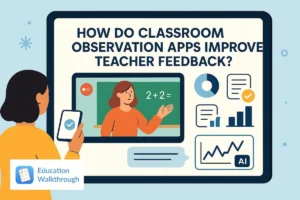When educators ask, “How do T-TESS domains and dimensions impact teacher ratings?” the answer often goes beyond numbers on a rubric. The T-TESS system, Texas’s official teacher appraisal framework, was built to emphasize growth, not just compliance.
At its core, it evaluates four domains: Planning, Instruction, Learning Environment, and Professional Practices. Each shapes how teacher effectiveness is measured and where opportunities for professional growth emerge.
At Education Walkthrough, we’ve seen firsthand how these domains influence teacher experiences. The ratings aren’t just about evaluation. They’re about unlocking potential, identifying strengths, and shining a light on areas where small shifts can make a big difference.
Key Takeaways
- Four Domains, One Framework: Planning, Instruction, Learning Environment, and Professional Practices work together to create a holistic view of teacher performance.
- The 80/20 Rule: T-TESS rubric weighting 80% observation/self-assessment and 20% student growth component.
- Opportunities for Growth: Most teachers fall within the Proficient range, indicating significant room for growth through targeted professional development.
- Beyond the Score: Strong T-TESS ratings can pave the way for leadership roles, mentorship opportunities, and special projects.
Understanding the Four Rubric Domains that Shape T-TESS Ratings
Each of the four core domains of the T-TESS rubric highlights a different layer of teaching practice. However, together, they paint a more holistic picture of an educator’s effectiveness.
At Education Walkthrough, we often remind administrators and teachers that strength in one domain naturally reinforces others, because excellent planning leads to better instruction. This, in turn, fosters a stronger classroom culture and ultimately supports professional growth.
Domain 1: Planning
Strong teaching begins with thoughtful T-Tess planning domain rating, and in many ways, this serves as the foundation for every other aspect. Planning measures how well lesson design connects to student needs, learning standards, and assessment data.
It includes:
- Standards and Alignment
- Data and Assessment
- Knowledge of Students
- Activities
We’ve seen teachers thrive when they use data not just as numbers, but as a story about where their students are and where they’re heading. For example, one teacher we worked with used student writing samples to adapt her lessons in real-time. Taking this approach shifted the focus to address gaps in grammar and comprehension.
Evidence collected during teacher observations ties directly to these elements, ensuring that planning is intentional, measurable, and impactful. In short, strong planning builds the roadmap that drives every successful instructional moment.
Domain 2: Instruction
Instruction is where plans come alive, and where teacher ratings often carry the most weight. This domain centers on:
- Achieving Expectations
- Content Knowledge and Expertise
- Communication
- Differentiation
- Monitor and Adjust
High-performing teachers in this area bring lessons to life by blending expertise with adaptability. These include asking purposeful questions, offering timely feedback, and shifting instruction on the fly. They make classrooms feel dynamic, not scripted.
Domain 3: Learning Environment
A strong learning environment is the heartbeat of a classroom. This domain evaluates:
- Classroom Environment/Routines/Procedures
- Managing Student Behavior
- Classroom Culture
When routines are clear, time is maximized and disruptions are minimized. Still, this domain is not simply about order. It’s about creating a safe, respectful, and collaborative space where students feel valued.
For example, studies show that implementing clear classroom procedures, paired with restorative discipline practices, resulted in a dramatic drop in student behavior referrals. That shift not only improved teacher ratings in Domain 3 but also boosted student achievement across the board.
A thriving classroom environment conveys high expectations while fostering trust and a sense of belonging. And when students know they’re in a supportive space, their willingness to engage, take risks, and learn increases exponentially.
Domain 4: Professional Practices and Responsibilities
Teaching extends beyond the classroom walls, and this domain captures the broader professional responsibilities that support schoolwide success.
It includes:
- Professional Demeanor and Ethics
- Goal Setting
- Professional Development
- School Community Involvement
From maintaining professional standards to setting and tracking personal growth goals, these responsibilities underscore the notion that effective educators are lifelong learners dedicated to their craft.
Documentation and goal-setting through the GSPDP process provide a structured framework for growth. At the same time, active collaboration with peers and the school community builds stronger, more supportive campuses.
How T-TESS Ratings Are Determined: Breaking Down the 80/20 Rule

T-TESS doesn’t solely look at what happens in the classroom on a single day. It combines multiple measures to capture both professional practice and student success. What percentage is observation in T-TESS, not to mention, student growth?
80% of the final rating is based on Observation and Self-Assessment, while 20% focuses on Student Growth. This balance ensures that teachers are evaluated not only on their instructional and professional practices, but also on their long-term impact on student learning.
How to Calculate T-TESS Summative Rating with Rubric and Student Growth
Here’s the T-Tess composite rating formula:
1. Observation/Self-Assessment (80%)
After completing observations and self-assessments in the four key domains (Planning, Instruction, Learning Environment, and Professional Practices), each domain will be rated on a scale from 1 to 5. These individual domain scores are averaged to get a composite score for this component.
2. Student Growth (20%)
This component measures the impact of your teaching on student learning, typically via state assessments or district-approved measures. The student growth score is calculated separately and weighted at 20% of the final summative rating.
3. Combine the Scores
Once you have your scores for both Observation/Self-Assessment and Student Growth, apply the 80/20 weighting:
- Multiply your composite Observation/Self-Assessment score by 0.80.
- Multiply your Student Growth score by 0.20.
- Add the two results together for your final summative rating.
Here is an example:
Let’s say your average score for Observation/Self-Assessment is 4.0 and your Student Growth score is 3.5. Here’s how the math breaks down:
- Observation/Self-Assessment:
4.0×0.80=3.24.0 \times 0.80 = 3.24.0×0.80=3.2 - Student Growth:
3.5×0.20=0.73.5 \times 0.20 = 0.73.5×0.20=0.7 - Final Summative Rating:
3.2+0.7=3.93.2 + 0.7 = 3.93.2+0.7=3.9
This would give you a 3.9, which typically falls under the “Accomplished” category on the T-TESS scale.
T-TESS Summative Matrix
Finally, all of this evidence is combined through the T-TESS Summative Matrix, which pulls both components together into a final rating. Understanding this 80/20 breakdown helps you focus on what you can control daily while maintaining a clear view of the bigger picture of student achievement.
How T-TESS Domains Shape Teacher Ratings in Practice

When we ask, “How do T-TESS domains and dimensions impact teacher ratings?” the answer is clear. The framework was designed to highlight strengths, pinpoint areas for improvement, and provide teachers with a fair and effective teacher evaluation. Each domain reflects a distinct dimension of teaching effectiveness, and together, they provide a comprehensive picture of professional practice.
Furthermore, T-TESS goes beyond a number on a scale. The T-TESS evaluation cycle is an ongoing series of feedback and reflection. By examining evidence across the domains, evaluators can celebrate what’s working while also identifying opportunities for targeted improvement.
Scoring and Performance Levels
Teacher ratings within T-TESS are built on a five-point scale that makes performance transparent and measurable:
- Distinguished (5 points)
- Accomplished (4 points)
- Proficient (3 points)
- Developing (2 points)
- Improvement Needed (1 point)
These levels guide professional conversations, help set meaningful goals, and ultimately determine a teacher’s summative rating. For teachers pursuing TIA (Teacher Incentive Allotment) designations (Recognized, Exemplary, or Master), consistent performance across these levels is crucial.
The Power of Growth and Goal Setting
Ratings are influenced by how well teachers show measurable growth throughout the school year. When professional development goals are aligned with student growth measures, both students and teachers move forward together.
Calculating your T-TESS summative rating is essential to understanding your performance as an educator. As we mentioned, the process considers both observation/self-assessment (80%) and student growth (20%).
The Role of the Teacher Incentive Allotment (TIA) in Teacher Ratings

Teacher Incentive Allotment (TIA) connects high performance in T-TESS evaluations to tangible rewards, motivating teachers to refine his or her practice and aim for excellence.
By linking recognition and financial incentives to performance, TIA emphasizes the value of continuous improvement. Teachers who excel in their T-TESS evaluations gain acknowledgment, career growth opportunities, and monetary rewards that reflect their impact on student learning.
Appraisal Process for TIA
The TIA appraisal process is designed to be thorough and fair. It includes:
- One 45-minute formal observation to capture a complete lesson in action.
- Two 15-minute partial walkthroughs that provide snapshots of teaching practice.
- Two unscored 3-minute spot observations for real-time insights.
- A summative evaluation conference at the end of the appraisal year to review performance and discuss growth.
Evaluators focus on observable actions and reflective discussions to ensure objectivity and impartiality. Maintaining organized documentation throughout the year is crucial for a seamless appraisal process, enabling teachers to demonstrate their growth and impact clearly.
Performance Gaps and Teacher Designation Levels
Performance gaps highlight differences in skill levels across educators and play a critical role in shaping professional development activities, ensuring that every teacher has the support needed to reach their full potential.
Recognizing Designation Levels
Texas categorizes teacher performance with TIA into Master, Exemplary, and Recognized levels, each representing a range of achievement:
- Master: Teachers in the top 5% of performance, requiring an average score of 4.5 across Instruction (Domain 2) and Learning Environment (Domain 3).
- Exemplary: Top 20% of teachers, with an average score of 3.9 across key domains.
- Recognized: Top 33%, requiring a 3.7 average across the exact domains.
These designation levels reflect not only instructional expertise but also the ability to consistently foster a positive, structured learning environment. Within Domain 2, Content Knowledge and Expertise (Dimension 2.2), Master teachers often achieve the highest scores, averaging 4.63, which illustrates how mastery in one area can reinforce overall performance.
Impact of Performance Gaps
Performance gaps are most noticeable where a majority of teachers fall into the Proficient category. While proficiency indicates solid teaching, it also signals significant opportunities for growth. Identifying these gaps enables districts to tailor professional development, coaching, and goal-setting initiatives, thereby strengthening instructional practices and student outcomes.
Enhancing Teacher Growth Through T-TESS

The steps of the T-TESS evaluation cycle emphasize the feedback loop between teachers and students, capturing the holistic nature of teaching while promoting continuous improvement. When performance gaps are identified, they guide the development of personalized growth plans, ensuring professional development is targeted and effective.
Goal-Setting and Professional Development Plans
A cornerstone of the texas teacher evaluation is SMART goal-setting. These goals provide a clear roadmap for teachers’ professional growth throughout the evaluation cycle:
- At the start of the year, teachers conduct self-assessments to identify areas for growth and set SMART goals that align with their professional development plans.
- During goal-setting conferences, teachers and appraisers finalize objectives and outline strategies to achieve them.
- Teachers share their Goal-Setting and Professional Development Plan (GSPDP) with appraisers before the end-of-year conference.
- Mentoring programs further enhance growth by offering feedback, fostering collaboration, and supporting the creation of inclusive, positive learning environments.
Clear, actionable goals help teachers focus on areas such as relationship-building, classroom culture, and instructional strategies that directly impact student success.
Feedback and Coaching Conversations
Actionable, evidence-based feedback is central to T-TESS. The process includes:
- Informal classroom walkthroughs and post-conference discussions offer real-time insights and opportunities for reflection.
- End-of-year conferences provide teachers with an opportunity to celebrate accomplishments, reflect on progress, and set new goals.
- Post-observation conferences within 10 working days of a teacher observation, including a discussion of ratings based on collected evidence.
Utilizing Student Growth Measures
Student growth measures are integral for evaluating teaching effectiveness and guiding instructional improvements. These measures provide objective evidence of student progress, enabling teachers to tailor their instruction to meet individual student learning objectives. Options include state assessments, local evaluations, and classroom-based measures, ensuring a comprehensive understanding of learning outcomes.
Summary
The T-TESS evaluation cycle is a powerful framework for understanding and improving teacher effectiveness. Focusing on the four key domains promotes continuous growth and balanced evaluation through the 80/20 rule, blending observations with student growth data.
At Education Walkthrough, we believe in turning this process into action. Tap into our classroom walkthrough platform to document, analyze, and track observations, ensuring every lesson counts and drives meaningful improvement in your classrooms.
Frequently Asked Questions
At Education Walkthrough, we are committed to helping you navigate T-TESS. Here’s what you need to know:
What is the purpose of T-TESS?
The purpose of T-TESS is to enhance teaching quality through a holistic approach that emphasizes the feedback loop between teachers and students, thereby facilitating continuous improvement based on evidence-based feedback.
What are the three components of T-TESS?
The three components of T-TESS are goal-setting and professional development plans, the evaluation cycle, and student growth measures. Understanding these elements is essential for effective participation in the T-TESS process.
How often are teachers appraised in PISD under T-TESS?
In PISD, teachers are typically appraised annually under T-TESS, though eligible teachers may experience appraisals every two years.
What are the eligibility requirements for less-than-annual evaluations under T-TESS?
To qualify for less-than-annual evaluations under T-TESS, a teacher must have an educator term contract, hold SBEC certification, be assigned to their certification area, and have a minimum of five years of employment with the District.
What must teachers do to qualify for a Teacher Incentive Allotment (TIA) designation?
To qualify for a Teacher Incentive Allotment (TIA) designation, teachers must undergo a full appraisal during their capture year. This evaluation is essential for meeting the designation requirements.



